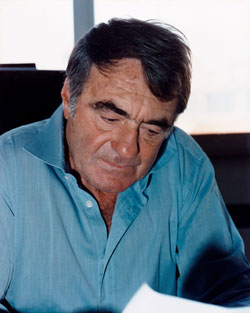Claude Lanzmann passes away at 92
Thu, 07/05/2018 - 1:24pm

USC Shoah Foundation is saddened to learn of the passing of Claude Lanzmann, whose monumental film "Shoah" introduced a new way of telling the story of the Holocaust. He died in Paris on Tuesday. He was 92.
Born Nov. 27, 1925, in Paris to Jewish parents, Lanzmann went into hiding during World War II. At 17, he joined the French resistance.
An intellectual and journalist, he gained international renown for for the documentary "Shoah." Without using any historical footage, the nine-and-a-half-hour oral history told the story of the Holocaust using only first-person testimony from both perpetrators and victims.
Lanzmann visited USC Shoah Foundation in 1993 to show his film "The Last of the Unjust," which focused on the Rabbi Benjamin Murmelstein, the last surviving member of the Jewish Council of the Theresienstadt ghetto. Using footage he filmed in 1975, Lanzmann reexamined one of the most controversial figures of the Holocaust. Because of his role as a leader of the ghetto and his connection to top Nazis, including Adolf Eichmann, Murmelstein was hated by many who felt he betrayed his fellow Jews. Instead of casting judgment, Lanzmann's film explored the moral quagmire that many people faced during the Holocaust.
As he started editing the film, Lanzmann said he began to consider the idea of appearing in it himself, since it was his own story as well as Murmelstein’s. Deciding to show himself on film was not an easy choice, he said.
“It required a form of courage. In Hebrew, chutzpah,” Lanzmann said at the screening. “But I thought it was the best way to sustain my thoughts about Murmelstein, to put myself in the middle of the screen. I don’t know if I was right to do this.”
Not one to hide his opinions, Lanzmann had initially expressed skepticism about the work of USC Shoah Foundation. In a 2010 interview with The New York Times, he was quoted as saying of the Institute's 55,000 testimonies of survivors and witnesses to the Holocaust and other genocides, "Who will see this?"
But by the time of his 2013 visit, he had changed his mind. When he reviewed the Institute's Visual History Archive, he said, "It is perfect work ... very important work. Many people and places in the world are now viewing this and there will be no end."
Like this article? Get our e-newsletter.
Be the first to learn about new articles and personal stories like the one you've just read.